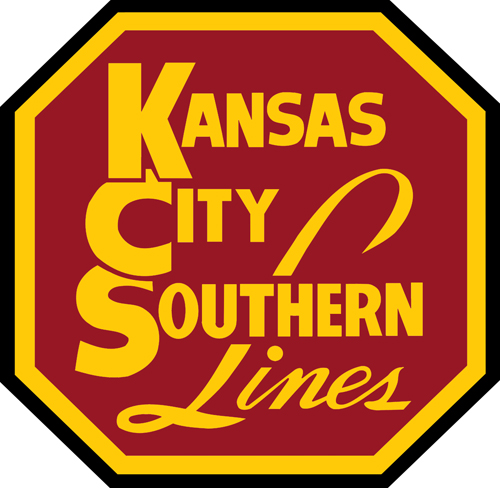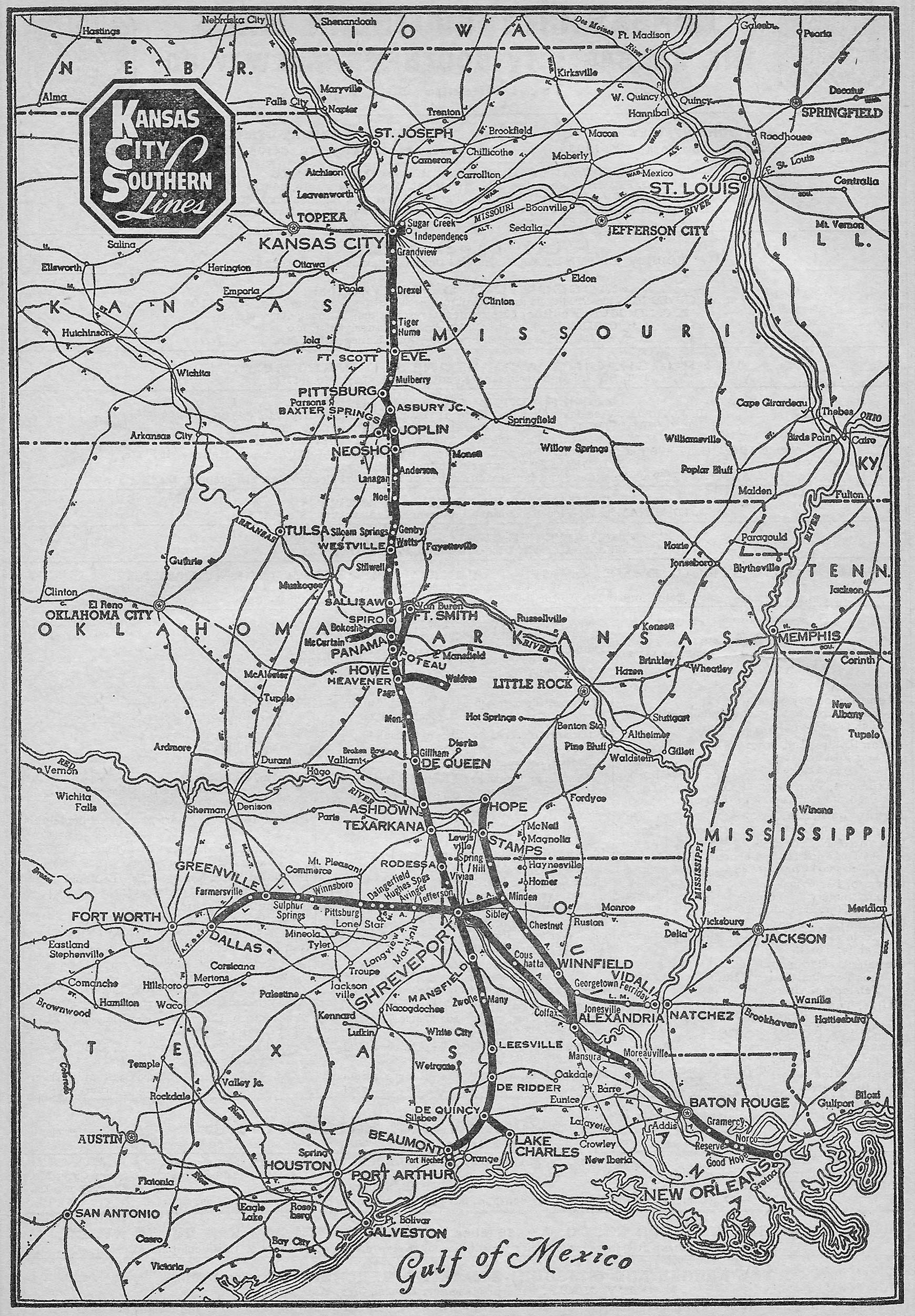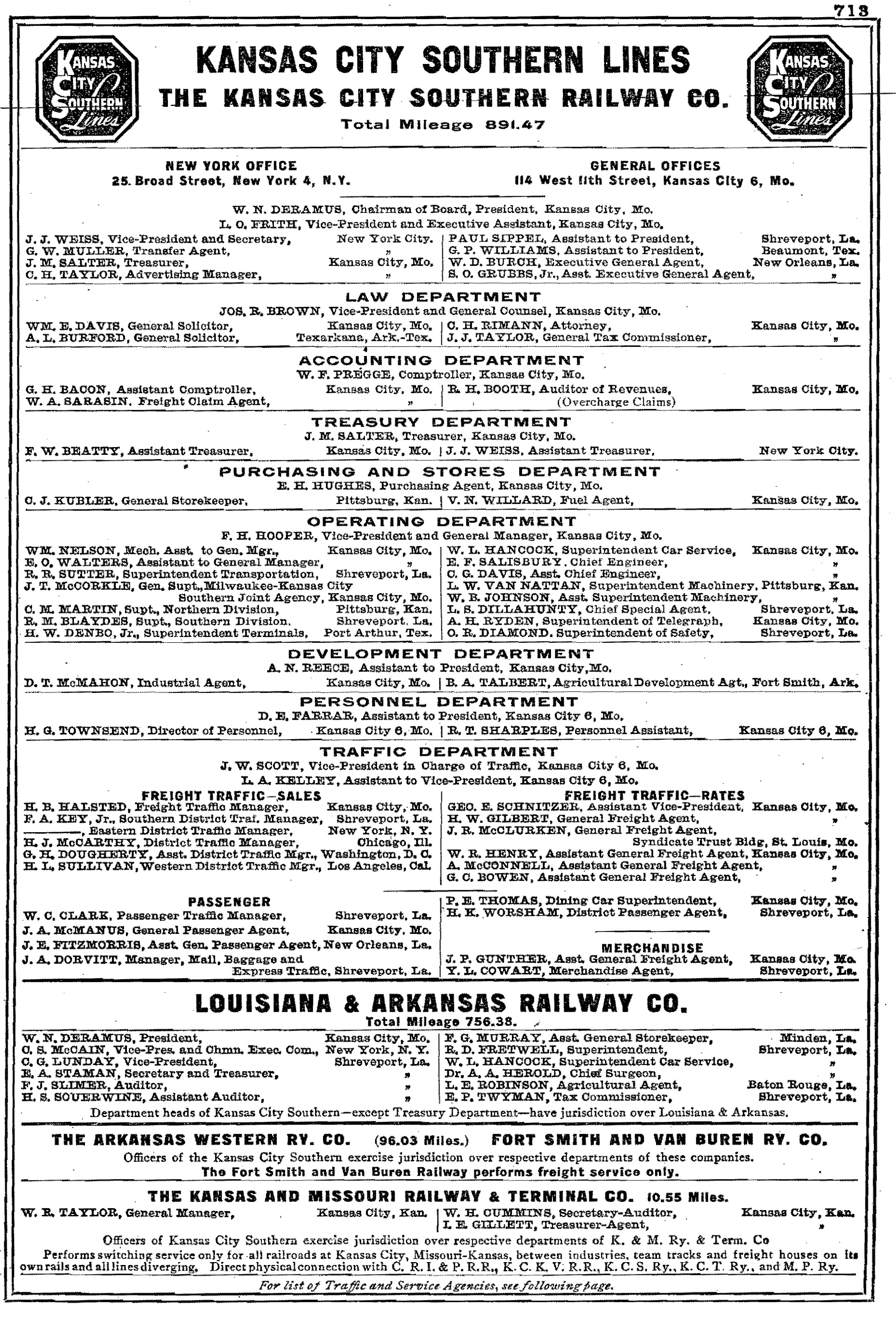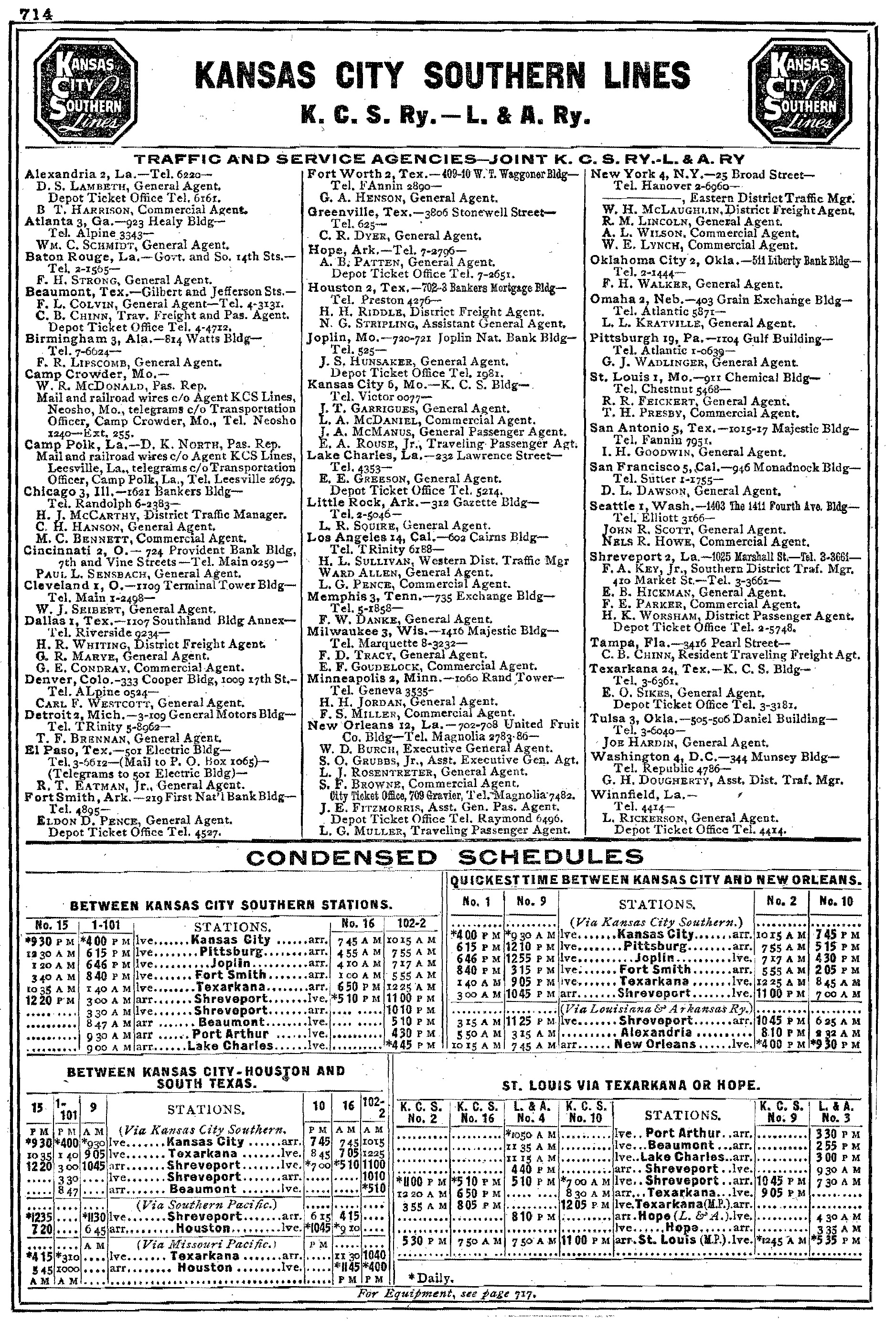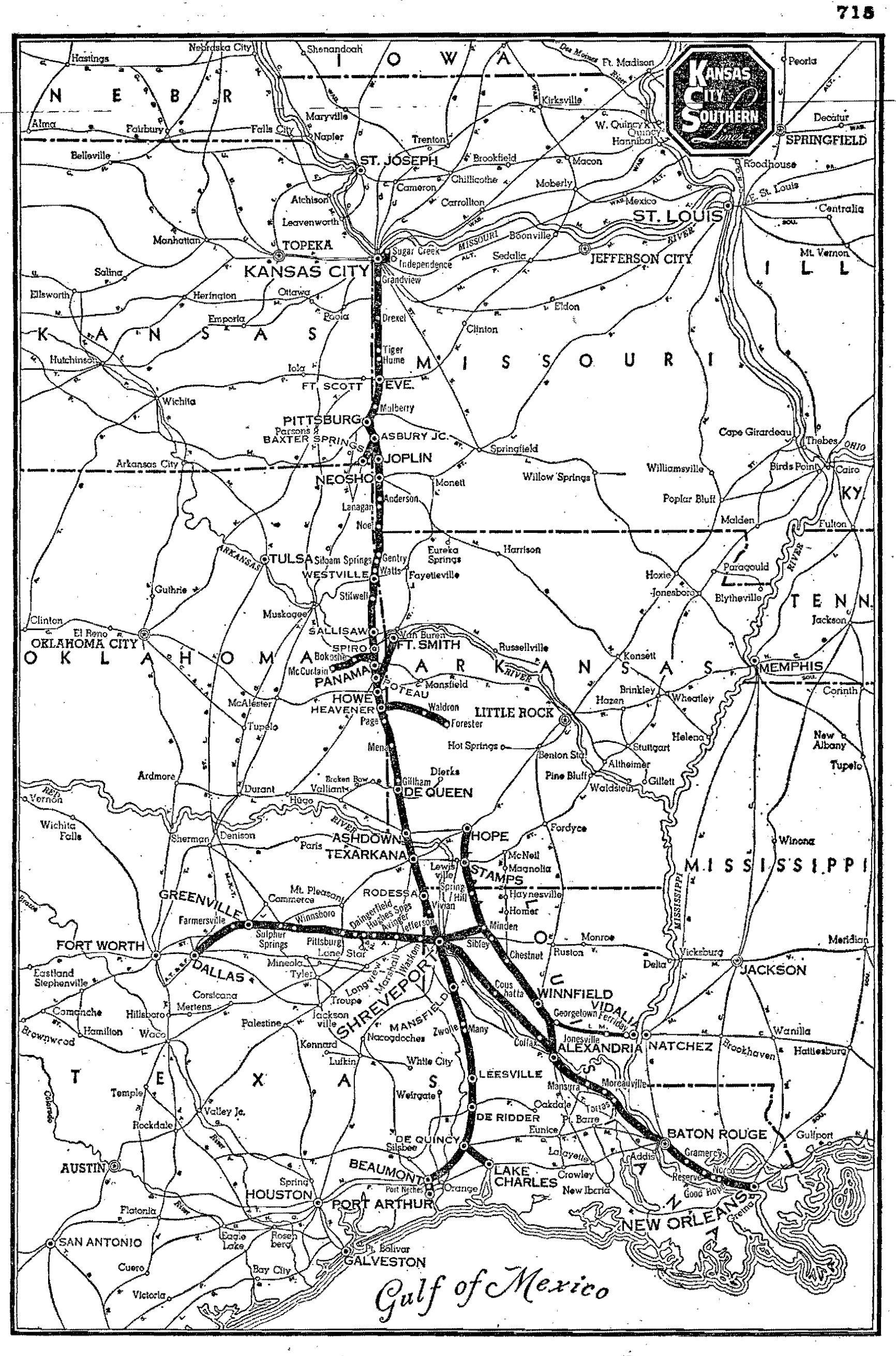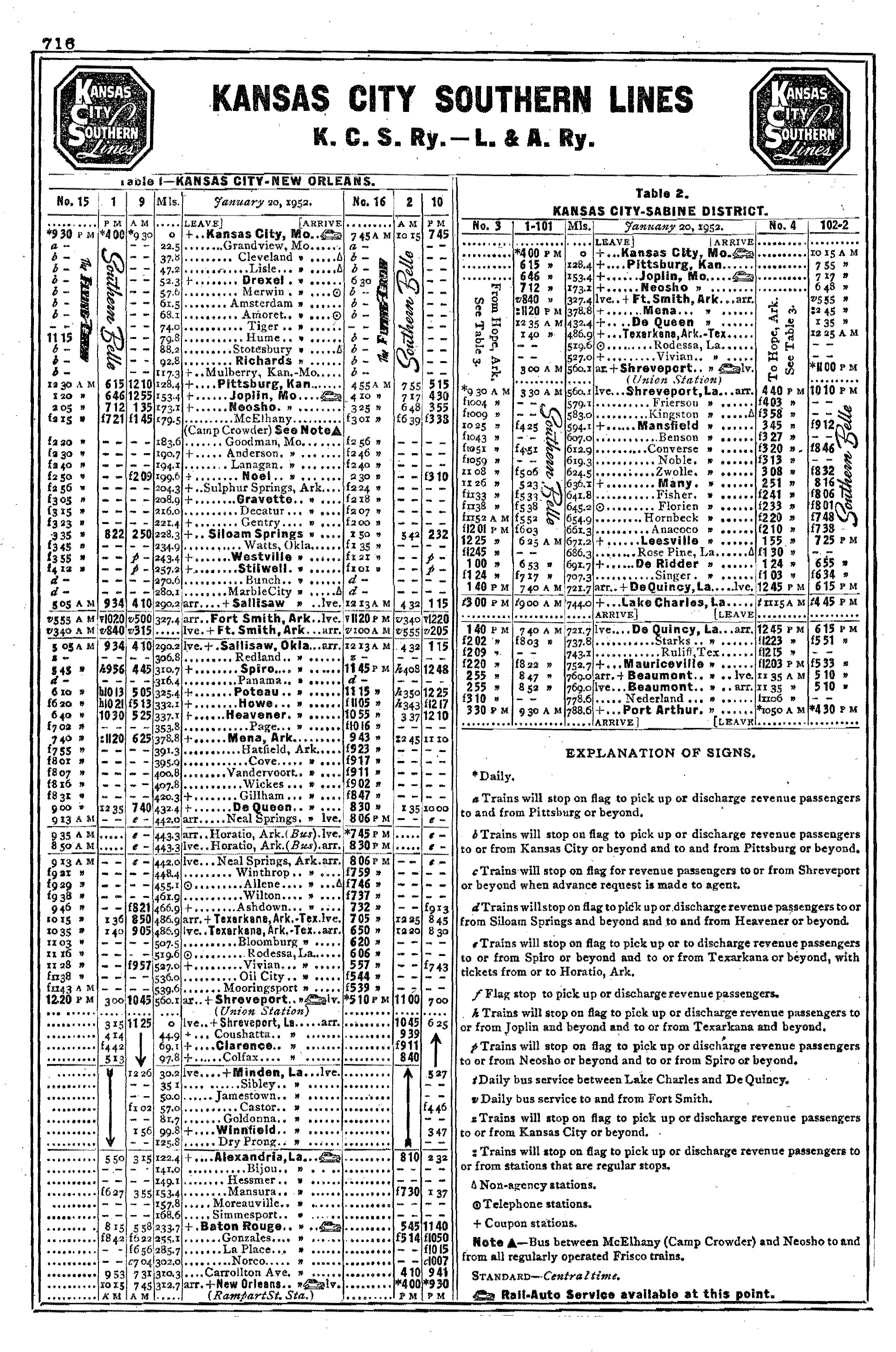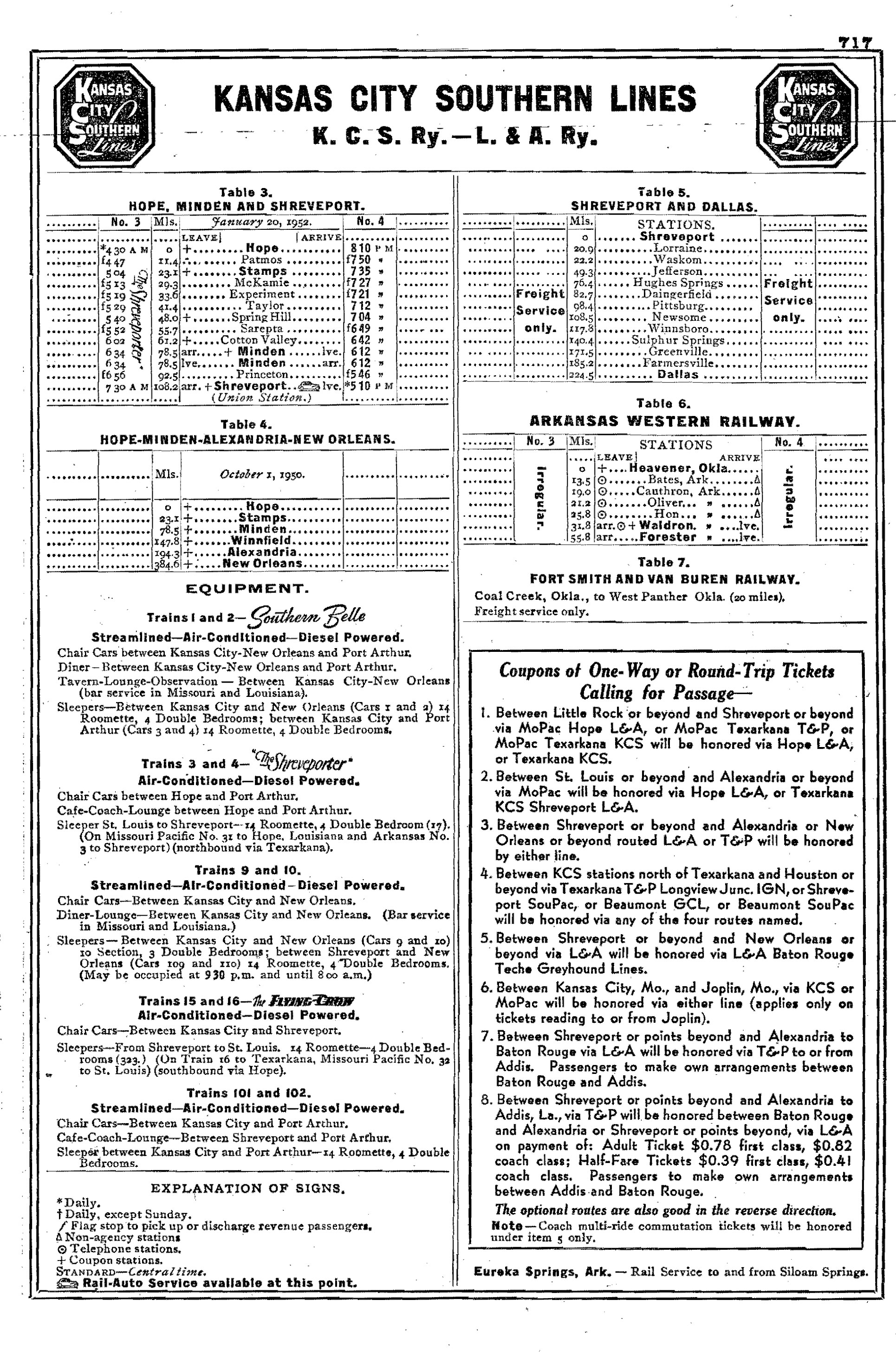Kansas City Southern Railway: Map, Photos, History
Last revised: October 12, 2024
By: Adam Burns
The Kansas City Southern Railway (KCS) was our country’s smallest Class I in the post-Staggers Act era, in terms of route miles. The Route Of The Southern Belle had always been a system surrounded by larger giants, even prior to the mega-merger movement during the classic era of the mid-20th century.
At its peak KCS operated about a 6,000-mile network, including service into Mexico, while employing more than 6,000. During its many years of operation the KCS had rocky periods although in its final years was regarded as a profitable railroad with strong leadership. Kansas City Southern formally disappeared as independent railroad on April 14, 2023.
Canadian Pacific Merger
- Alas, it became another fallen flag when Canadian Pacific announced on March 21, 2021 it would acquire the road for $25 billion (the final total was later increased to $31.6 billion.)
In the original deal (since amended), reported by Bloomberg, KCS investors were to receive 0.489 of a CP share and $90 in cash for each share they hold, valuing the stock at $275 apiece.
The new railroad became known as Canadian Pacific-Kansas City (CP-KC) with a 20,000-mile network, nearly 20,000 employees, and an annual revenue of about $8.7 billion.
Interestingly, a counterproposal by rival Canadian National nearly won the day. CN's bid of $33.6 billion to directly acquire KCS would likely have been approved by KCS shareholders.
However, the Surface Transportation Board unanimously killed the voting trust on August 31, 2021, which paved the way for the renewed CP-KCS merger. The STB approved the sale in March, 2023 and the new railroad began operations in April, 2023. -
Photos
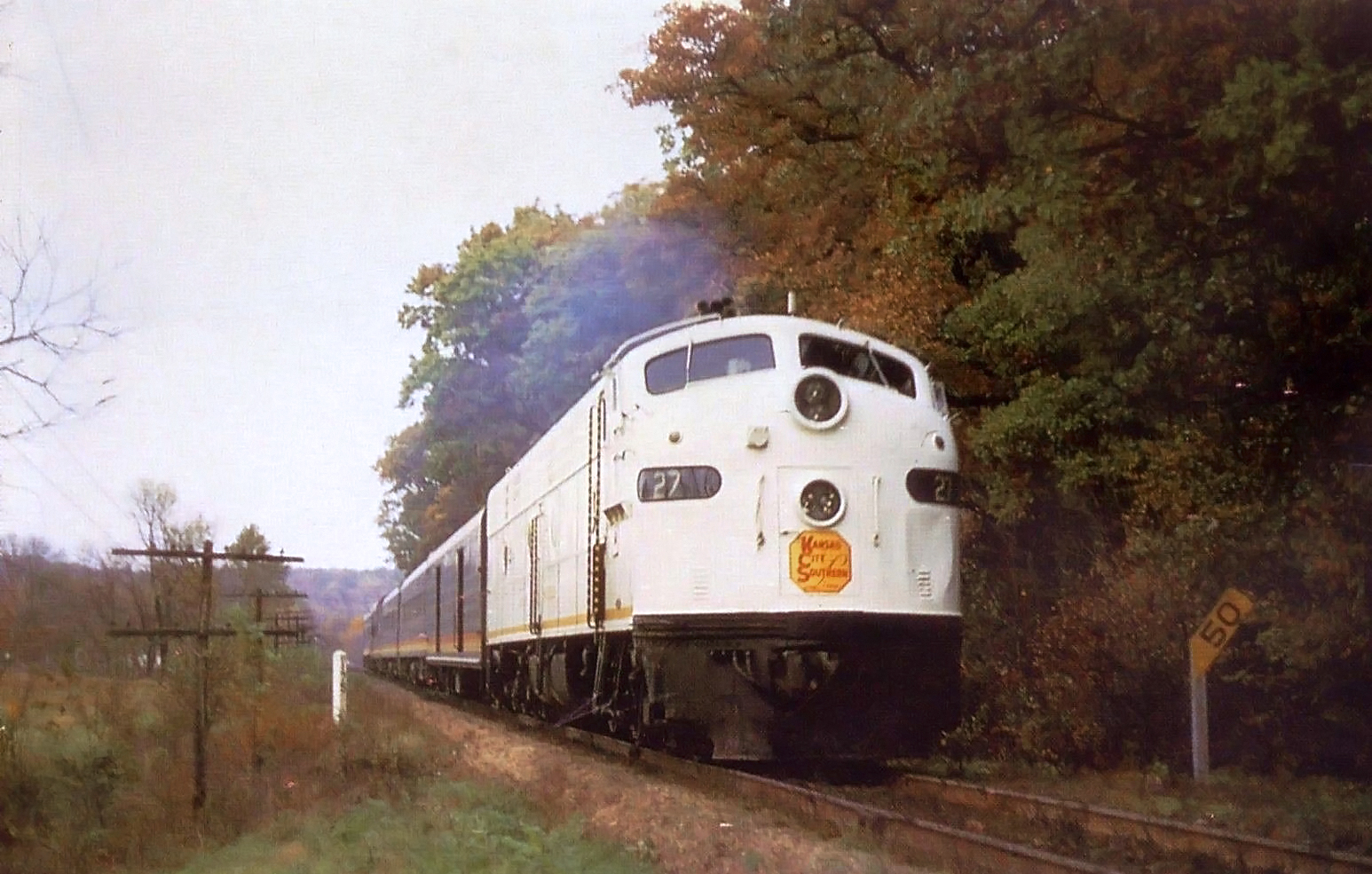 Kansas City Southern E8A #27 has the last "Southern Belle" (Kansas City - New Orleans) near Pittsburg, Kansas on November 2, 1969. Richard Wallin photo.
Kansas City Southern E8A #27 has the last "Southern Belle" (Kansas City - New Orleans) near Pittsburg, Kansas on November 2, 1969. Richard Wallin photo.History
The Kansas City Southern's story is actually quite recent when compared to the railroad industry as a whole; the road's immediate ancestry began on January 8, 1887 with incorporation of the Kansas City Suburban Belt Railroad, promoted by Arthur Stilwell.
The terminal line served the local Kansas City region, connecting Argentine with nearby Independence via the downtown area.
In all, the KCSB utilized 40 miles of track serving packing houses, grain elevators, stockyards, and various other industries. According to the Kansas City Southern Historical Society it officially began operations on August 18, 1890.
At A Glance
856 (1930) 962 (1950) 2,995 (2000) 6,700 (2019) |
|
121 (1963) 949 (2019) |
|
581 (1963) 17,500 (2019) | |
Kansas City - Shreveport, Louisiana - Port Arthur, Texas Dallas - Shreveport - New Orleans Shreveport - Minden, Louisiana - Hope, Arkansas Minden - Alexander, Louisiana | |
Port Arthur Route Route Of The Southern Belle | |
Sources (Above Table):
- Kansas City Southern. "For The Long Haul: 2019 Sustainability Data Update." https://www.kcsouthern.com/en-us/pdf/community/kcs-2019-sustainability-report.pdf. Page 2. August 24, 2022.
- Schafer, Mike. More Classic American Railroads. Osceola: MBI Publishing, 2000.
- Burns, A.J. and Burns, J.F. "Kansas City Southern Railway Company, The." Official Guide Of The Railways And Steam Navigation Lines Of The United States, Port Rico, Canada, Mexico, And Cuba, The. Volume 62. Issue 8. January, 1930. Pages 738-740.
The other early component was the Texarkana & Northern Railway. At first, this system had no actual ties to the Stilwell's operations. It had originally been chartered on June 18, 1885, intended as a logging operation that opened 10 miles from Texarkana north to the Red River.
On July 9, 1889 it changed its names as the Texarkana & Fort Smith Railway, opening an additional 16 miles to Wilton, Arkansas by 1892.
The Texas State Historical Association (TSHA) notes that year, on December 13th, the railroad was acquired by the Arkansas Construction Company, a subsidiary of Stilwell's Kansas City, Pittsburgh & Gulf Railroad.
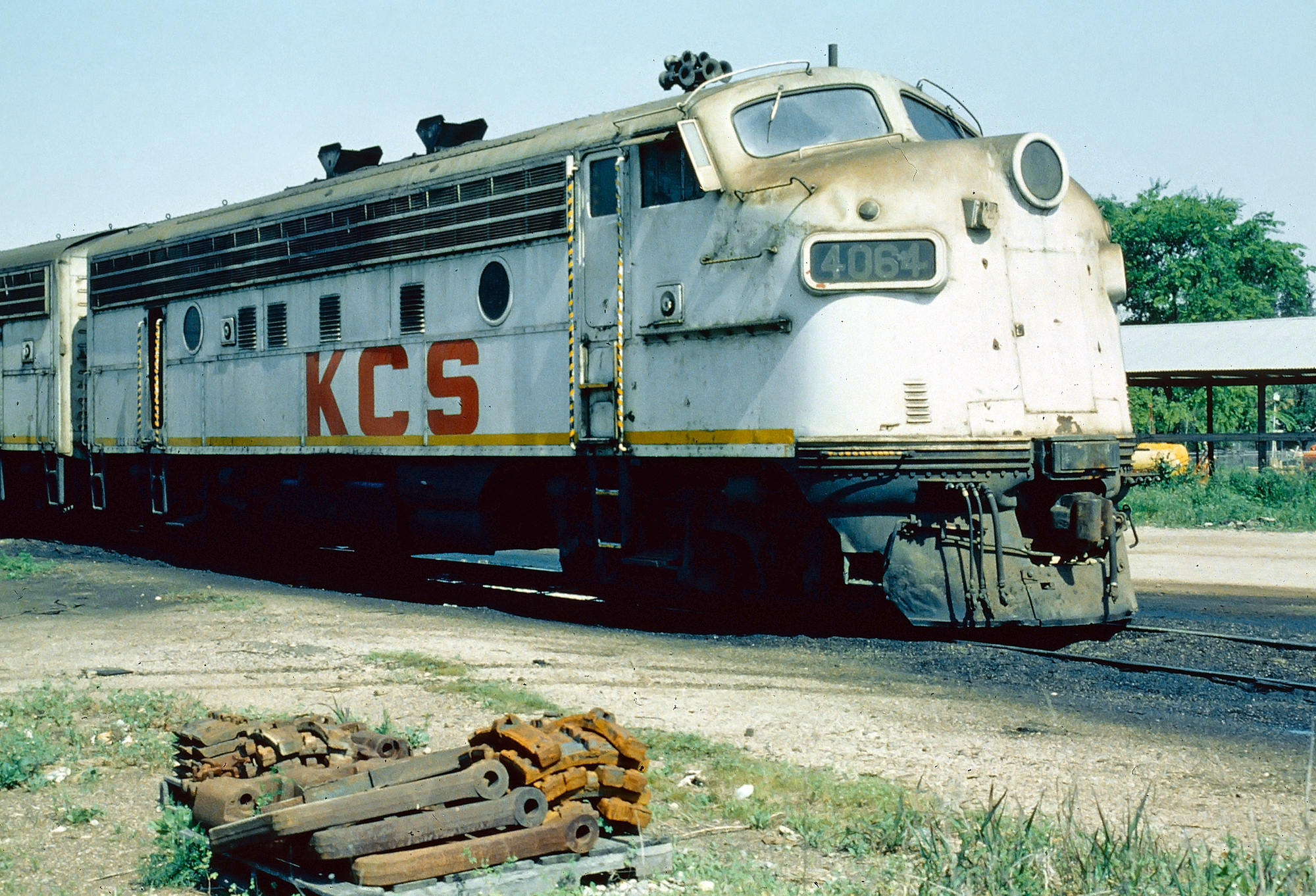 Kansas City Southern F7A #4064 and other Fs are tied down in their typical spot behind the depot at Sulphur Springs, Texas in the summer of 1983. These were the last Fs used in freight service on a Class I. They handled lignite to TXU's coal-fired power plant in Pittsburg, which was carried to the facility by the company's own electrified railroad. Mike Bledsoe photo. American-Rails.com collection.
Kansas City Southern F7A #4064 and other Fs are tied down in their typical spot behind the depot at Sulphur Springs, Texas in the summer of 1983. These were the last Fs used in freight service on a Class I. They handled lignite to TXU's coal-fired power plant in Pittsburg, which was carried to the facility by the company's own electrified railroad. Mike Bledsoe photo. American-Rails.com collection.The KCP&G had been organized on November 6, 1889 and Stilwell had plans for the railroad to provide the shortest route to the Gulf of Mexico, connecting its namesake city with the coast.
The system's purpose was two-fold; to give farmers a means of exporting their goods as well as handle imported products.
Unfortunately, this plan was never successful although not before Stilwell had completed his vision. During the Panic of 1893 the KCP&G lost its financial backing after having only reached Pittsburg, Kansas.
Logo
Undaunted, Stilwell looked anywhere for possible monetary backing to complete his project. As Mike Schafer's, "More Classic American Railroads," notes he was able to do this by garnering help through close friend George Pullman, head of the powerful Pullman Palace Car Company; together they raised $3 million in securities from Holland.
With new capital in hand, Stilwell opened coastal facilities on the Gulf at a location he named for himself, Port Arthur, Texas while "Last Spike" ceremonies were held at Beaumont on September 11, 1897.
Only two years after it all began the KCP&G fell into bankruptcy in 1899, emerging on April 1, 1900 as the Kansas City Southern Railway. The receivership forced Stilwell out and his involvement with the company ended.
As previously mentioned, his railroad's dream was not particularly successful as, even after reorganization, it struggled to earn a profit.
There was little in the way of consistent, high-volume traffic which forced the KCS to rely upon local agriculture, grain, and less-than-carload freight for most of its income. In addition, passenger traffic was thin.
As it turns out, fate had a bright future for the company when its savior came in the way of "black gold," oil. As it turns out the railroad's main line was situated right next to a discovery made near Beaumont, Texas.
In 1892 George O'Brien, George Carroll, Pattillo Higgins, Emma John, and J. F. Lanier, founded the Gladys City Oil, Gas & Manufacturing Company.
Within a few years nearly half the group had given up but in 1895 a determined Anthony Lucas signed a lease with the remaining partners, believing strongly that oil was located in the Gulf Coast's salt domes.
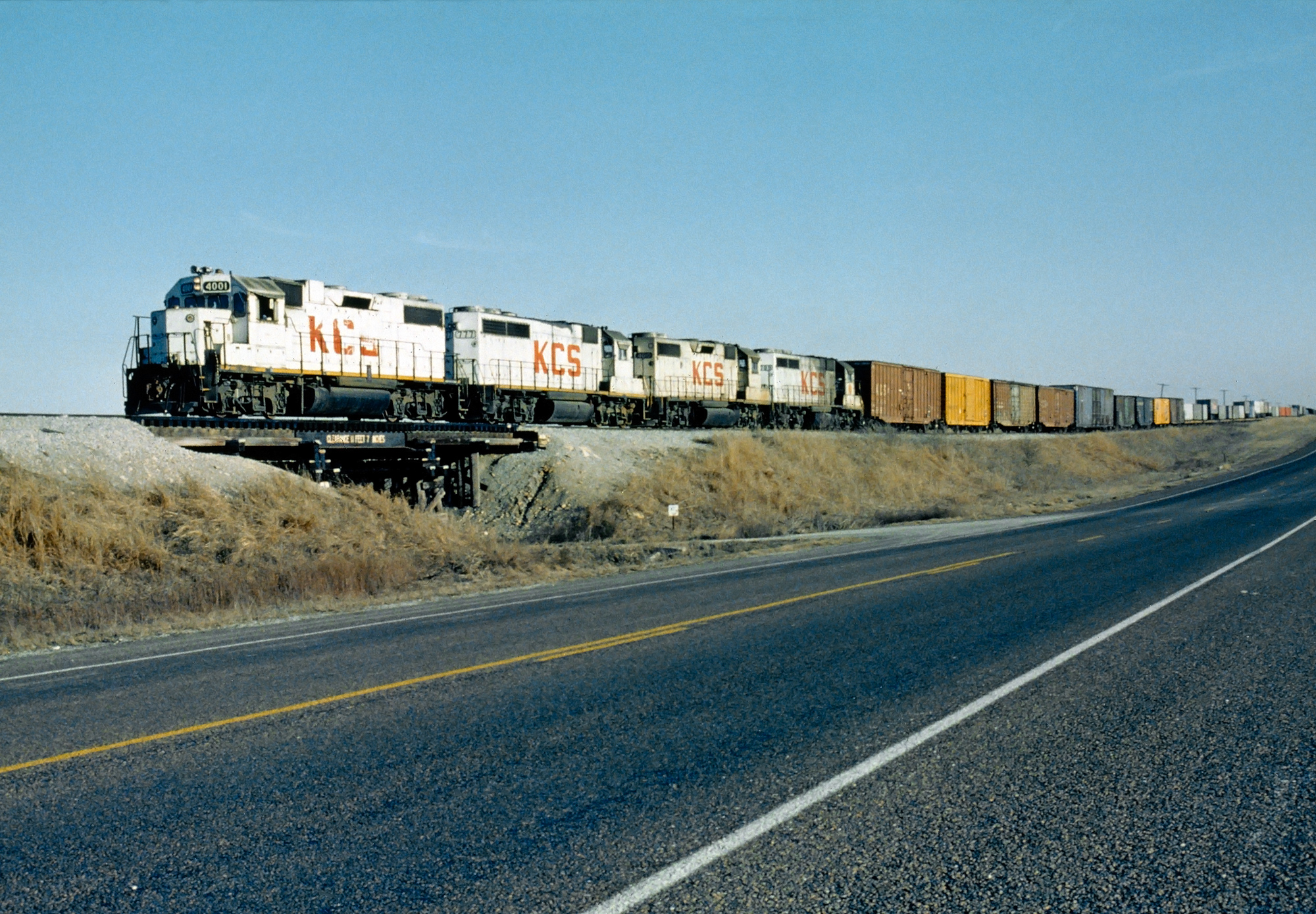 Kansas City Southern GP38-2 #4001, GP40 #777, GP38-2 #4010, and SD50 #705 lead a westbound outside of Cresson, Texas, bound for Brownwood, circa 1983. Today, this line is operated by the Fort Worth & Western. Mike Bledsoe photo. American-Rails.com collection.
Kansas City Southern GP38-2 #4001, GP40 #777, GP38-2 #4010, and SD50 #705 lead a westbound outside of Cresson, Texas, bound for Brownwood, circa 1983. Today, this line is operated by the Fort Worth & Western. Mike Bledsoe photo. American-Rails.com collection.After considerable expense and effort Lucas and Hamills finally hit pay dirt. The THSA notes that on January 10, 1901, at a depth of 1,139 feet, a huge geyser of oil, 100 feet high, spilled from their well (listed as "Lucas #9") located in eastern Jefferson County, south of Beaumont.
The area became known as the Spindletop Oil Field, producing tens of thousands of barrels every day. The natural resource could not have been found at a better time as the KCS was likely headed towards another bankruptcy.
Thanks to the many uses of oil the railroad not only moved raw black gold but also gasoline and various other petrochemicals as the energy industry sprang up along the Gulf. This new traffic would account for well over one-third of the system’s profits for much of its early years (and continue to generate healthy income years).
With a newfound source of revenue, and new leadership under Leonore Fresnel Loree (1906), the KCS looked towards expansion during the 20th century.
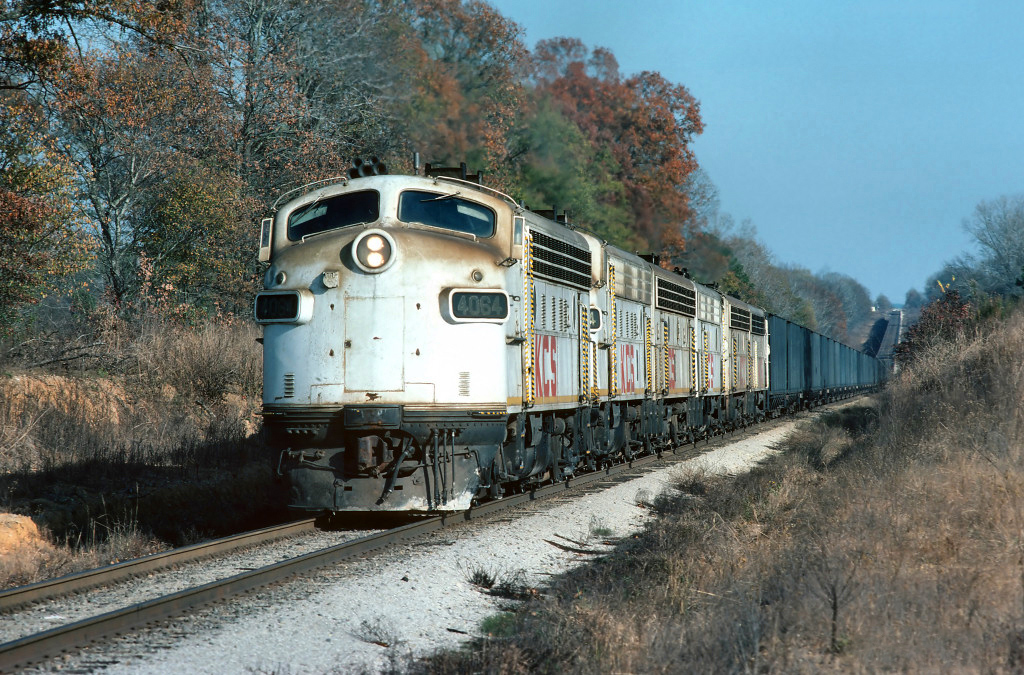 Kansas City Southern's remaining F7s lead a long train of empty hoppers heading westbound near Sulphur Springs, Texas during December of 1981. Gary Morris photo.
Kansas City Southern's remaining F7s lead a long train of empty hoppers heading westbound near Sulphur Springs, Texas during December of 1981. Gary Morris photo.Expansion
While it took many years to see the fruits of this labor fulfilled, by the late 1930s the KCS had acquired new markets in Dallas and New Orleans. At first the railroad zeroed in on the nearby Missouri-Kansas-Texas (Katy) and St. Louis Southwestern (Cotton Belt) railroads.
However, the Interstate Commerce Commission forced it to divest of these holdings during the 1920s. It would later pick up the Louisiana & Arkansas (second) in 1939, providing a roughly east-to-west routing from New Orleans to Dallas, Texas via Shreveport.
Sysytem Map
There was also an extension from Alexandria, Louisiana to Hope, Arkansas where additional interchanges were established with Missouri Pacific, Rock Island, and Cotton Belt.
The L&A was the greatest component to the historic KCS system although other minor acquisitions included the Kansas & Missouri Railway & Terminal Company (K&M), Fort Smith & Van Buren (FS&VB), Arkansas Western (AW), and the Maywood & Sugar Creek (M&SC).
By 1950, the KCS owned a network of 962 miles and had it forever remained this size would likely be only a Class II, "regional," today. For roughly the first half of the 20th century the KCS prospered, earning considerable profits for a system its size.
This was in large part due to the efforts of William Deramus who spent millions in upgrades through the 1950s by laying new ties, improving signaling for faster and more efficient operations (Centralized Traffic Control in 1943), completing dieselizing by 1953, opening the large Deramus Yard at Shreveport in 1956, and operating long freights of 200 cars or more.
After the nation's severe 1958 recession (also referred to as the Eisenhower Recession), the KCS experienced a slow and worsening decline.
It had purchased new locomotives beginning in the mid-1960s to improve operations and handle the heavier freight trains of the era; notably SD40's, SD40-2's, GP30's, and GP40-2's (road-switchers which replaced older models like the F3 and F7 cab units).
Predecessors
Fort Smith & Van Buren Railway
The FS&VB entered the KCS fold on September 30, 1939 when it was formed to acquire the Coal Creek to McCurtain, Oklahoma segment of the former Fort Smith & Western Railroad. The FS&W was chartered on January 25, 1899 and by 1903 opened from Coal Creek to Guthrie, Oklahoma via Oklahoma City.
The road struggled financially and was reorganized as the Ft. Smith & Western Railway in the early 1920s. It continued to falter into the Great Depression and finally shutdown on February 9, 1939 after which time the KCS took over the above-mentioned segment.
Graysonia, Nashville & Ashdown Railroad
The GN&A was another timber road originally chartered on June 16, 1906 as the Memphis, Paris & Gulf Railroad. Within a few years it had opened 41 miles from Ashdown, Arkansas (and a connection to the KCS) to Murfreesboro via Nashville.
On June 1, 1910 its name was changed to the Memphis, Dallas & Gulf controlled by the Graysonia & Nashville Lumber Company. On March 21, 1915 it opened between Hot Springs and Texarkana, Arkansas via Ashdown comprising a system of some 115 miles.
Unfortunately, it fell into bankruptcy a few years later and segments were sold off. On August 15, 1922 the Ashdown to Shawmut section (61 miles) became the Graysonia, Nashville & Ashdown while it further shrunk in 1926 to just a 32-mile system linking Nashville and Ashdown. The GN&A remained a small short line operation until its acquisition by KCS on July 13, 1993.
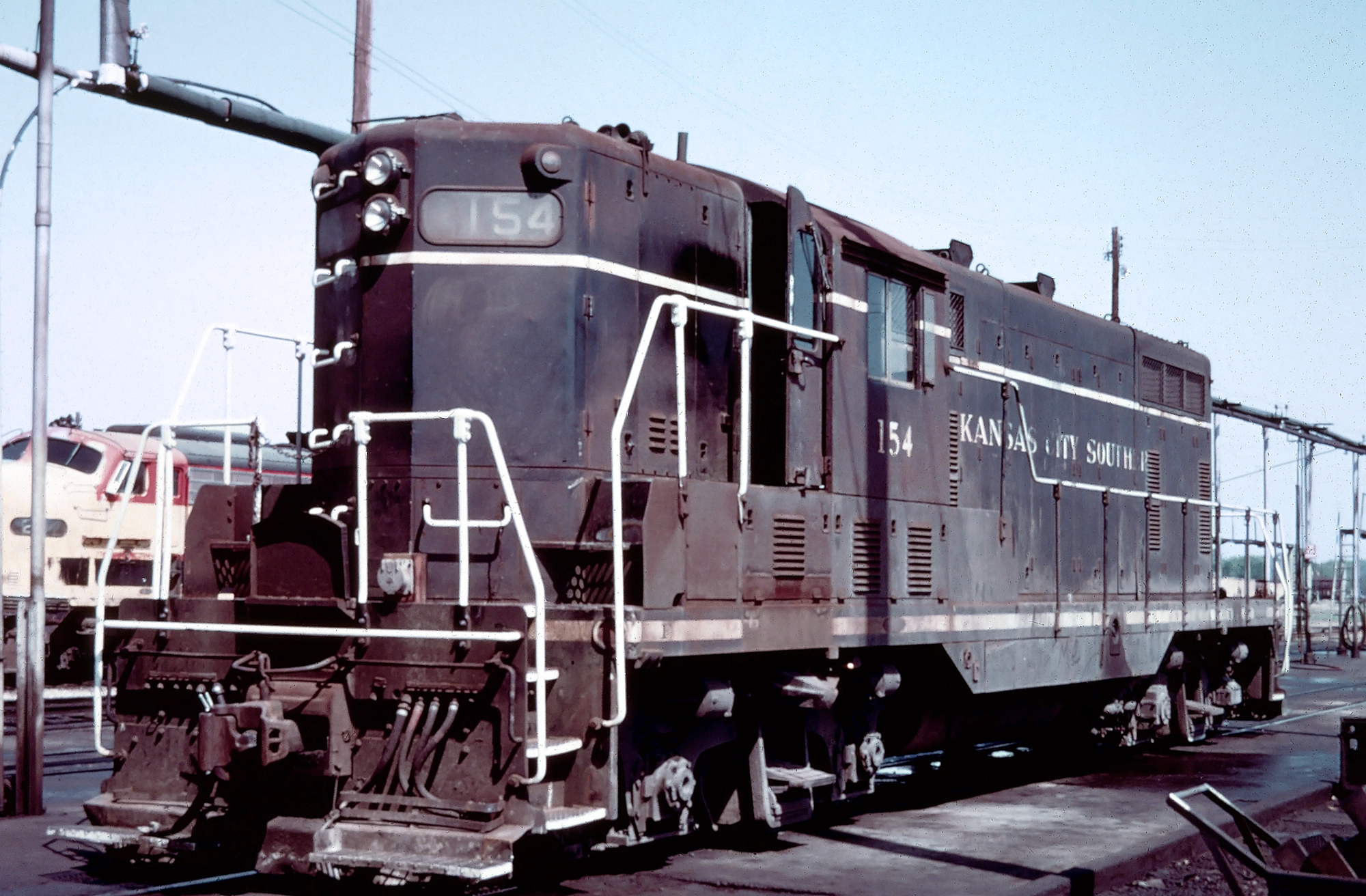 Kansas City Southern GP7 #154 at the engine terminal in Pittsburg, Kansas, circa 1967. American-Rails.com
collection.
Kansas City Southern GP7 #154 at the engine terminal in Pittsburg, Kansas, circa 1967. American-Rails.com
collection.Louisiana & Arkansas Railway
The L&A was the largest component of the historic Kansas City Southern. It was actually a merger itself of two subsidiaries, the original Louisiana & Arkansas Railway and Louisiana Railway & Navigation Company.
According to the KCSHS the earliest predecessor of the first L&A was launched by logger William Buchanan around 1896 to serve his sawmill near Stamps, Arkansas. It was one of the many, unincorporated and privately owned little railroads that could so often be found with such operations then.
On March 18, 1898 it was officially chartered as a common-carrier, the Louisiana & Arkansas Railway, as Buchanan looked to continue growing his timber holdings. Within just a few years he had built new lines or acquired others (Arkansas, Louisiana & Southern) to operate a system stretching some 273 miles between Alexandria, Louisiana and Hope, Arkansas; the former extension opened on July 1, 1906 while the latter was reached on June 1 1903.
A few years later, on July 1, 1910, the L&A reached Shreveport, Louisiana thanks to its acquisition of the Minden East & West Railroad (via Minden). During Kansas City Southern's, Harvey Couch era, he acquired control of the L&A and LR&N on January 16, 1928. Later that year, on July 7th he formed a second Louisiana & Arkansas Railway Company combining both into the new L&A on May 8, 1929.
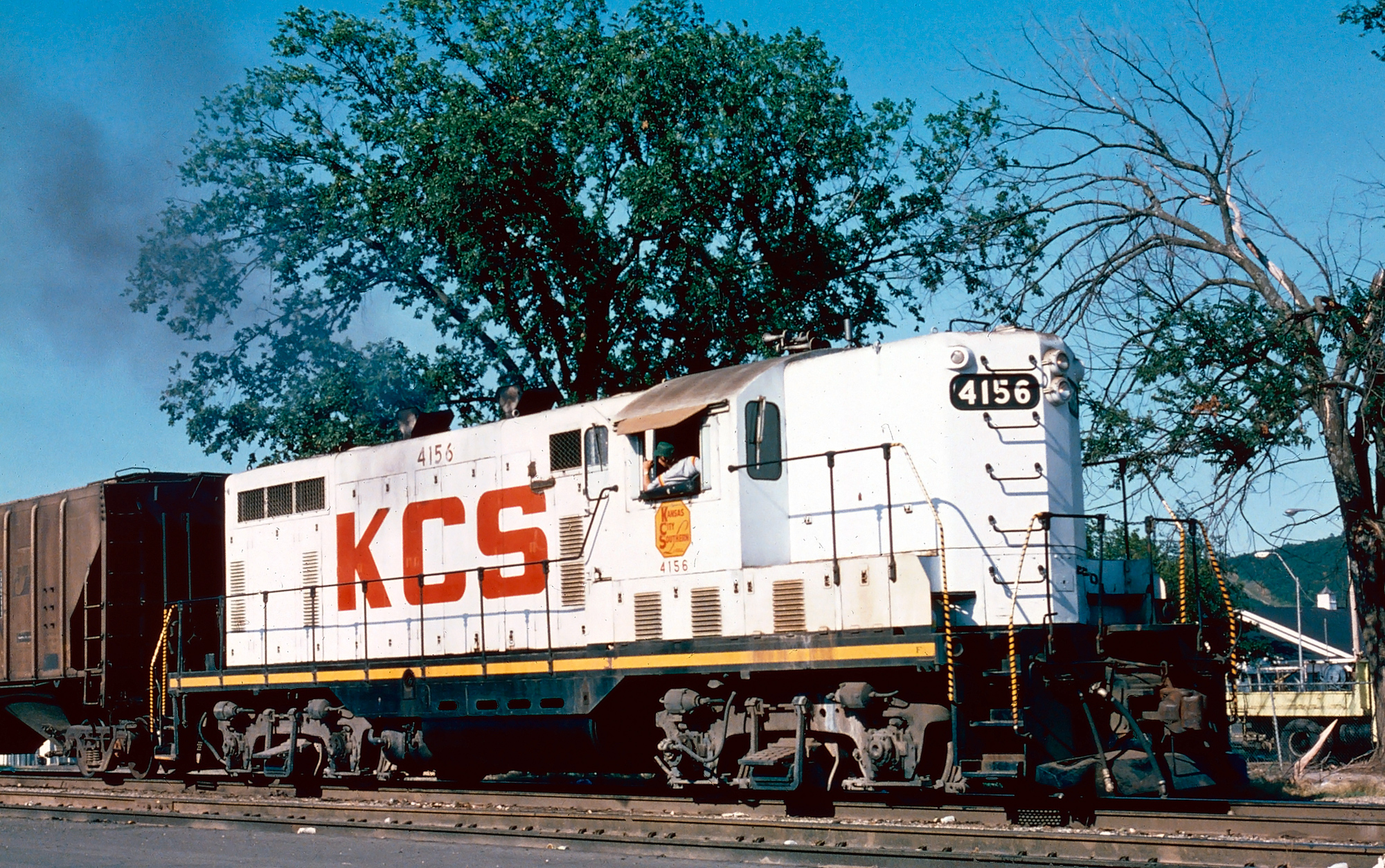 Kansas City Southern GP7 #4156 at Heavener, Oklahoma, circa 1984. Mike Bledsoe photo. American-Rails.com collection.
Kansas City Southern GP7 #4156 at Heavener, Oklahoma, circa 1984. Mike Bledsoe photo. American-Rails.com collection.Louisiana Railway & Navigation Company
The LR&N's earliest predecessor was the Shreveport & Red River Valley Railroad, a project started by William Edenborn in 1896 to connect Shreveport with New Orleans.
The first segment opened between Shreveport and Coushatta, Louisiana on October 1, 1898 and reached as far south as Mansura by September of 1902.
At this time the system was reorganized as the Louisiana Railway & Navigation Company on May 9, 1903, opening to New Orleans on April 14, 1907. The LR&N continued to expand following the completion of its original main line.
Looking to the west it acquired a former branch of the Missouri-Kansas-Texas Railroad ("The Katy") between McKinney, Texas and the Louisiana state line (near Waskom, Texas) on April 1, 1923.
To provide service on this disconnected segment the LR&N acquired trackage rights over the Texas & Pacific (Missouri Pacific) west of Shreveport. The line to Dallas became a very important component of the KCS system and still witnesses considerable use today.
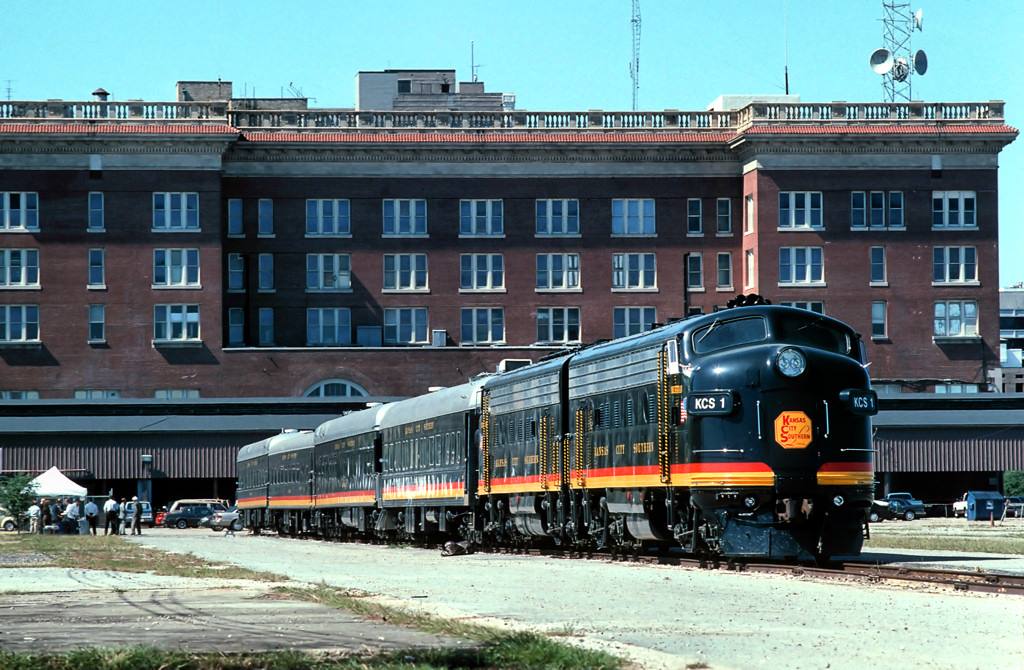 Kansas City Southern's business train at Houston Union Station in October of 1996. Today, the Houston Astros' Minute Maid Park occupies this location. Gary Morris photo.
Kansas City Southern's business train at Houston Union Station in October of 1996. Today, the Houston Astros' Minute Maid Park occupies this location. Gary Morris photo.However, it began a program of deferred maintenance in the 1960s to offset the slow period, which produced a better bottom line. Unfortunately, such tactics are only "successful" for short periods and can have long-lasting, very negative, effects if carried out over many years.
This turned out to be the case for KCS; with top management too focused on other things the railroad's physical plant slipped into a decaying state of repair and it all came to head in late 1972. With worn out ties and the road's infrastructure unable to bear the weight of multi-ton trains, derailments occurred one after another.
If it were not for record volumes of traffic the railroad could have faced a fatal problem, similar to its northern neighbor the Rock Island. While deferred maintenance offers short term relief for a railroad's bottom line in the long term it can cost substantially more to alleviate as the KCS found out.
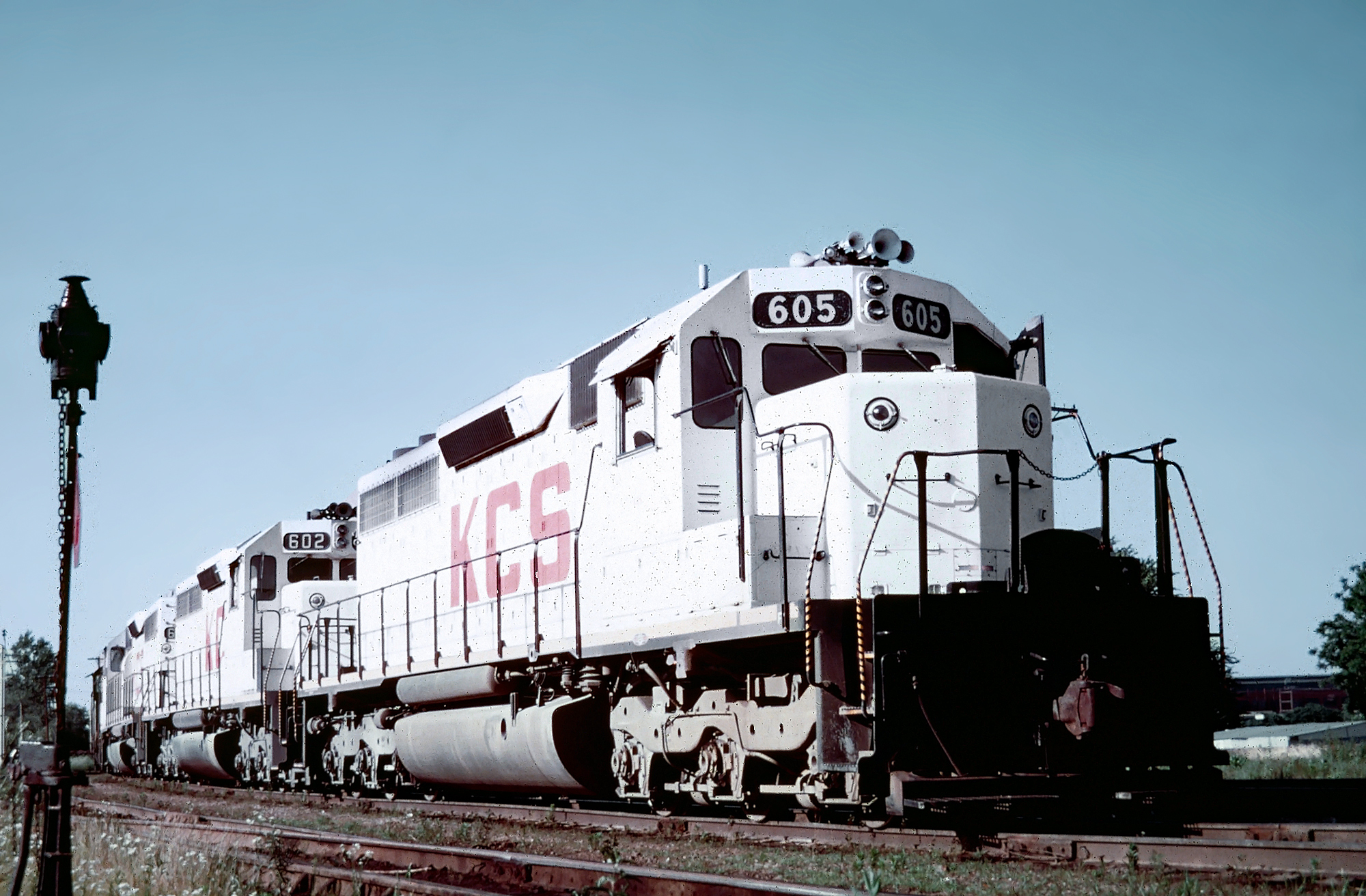 A trio of new Kansas City Southern SD40's, including #605 and #602, are seen here in Pittsburg, Kansas, in the summer of 1967. American-Rails.com collection.
A trio of new Kansas City Southern SD40's, including #605 and #602, are seen here in Pittsburg, Kansas, in the summer of 1967. American-Rails.com collection.Under the direction of new president Thomas S. Carter in 1973, who replaced Deramus's son (William N. Deramus III), the modern day KCS system began to take shape.
He spent millions to improve the company's physical degradation although things got worse before they got better; Mr. Schafer notes that 1974 cost the railroad $2 million in damages via 41 derailments.
Thankfully, with plenty of traffic to keep the railroad stable (coal and petrochemicals in particular) it began to pull out of the mess and the 1980s were a prosperous period.
Into the 1990s and early 2000s numerous acquisitions saw the railroad grow substantially, expanding six-fold over its historic size.
The first occurred on January 1, 1994 when it formerly took over MidSouth Rail Corporation, a 1,212-mile regional that had launched operations on March 31, 1986 utilizing former Illinois Central and Gulf, Mobile & Ohio trackage.
The lines ran east of Shreveport to Jackson and Meridian, Mississippi before turning north into Counce, Tennessee. In addition, there was access to Tuscaloosa and Birmingham, Alabama as well as Gulfport, Mississippi.
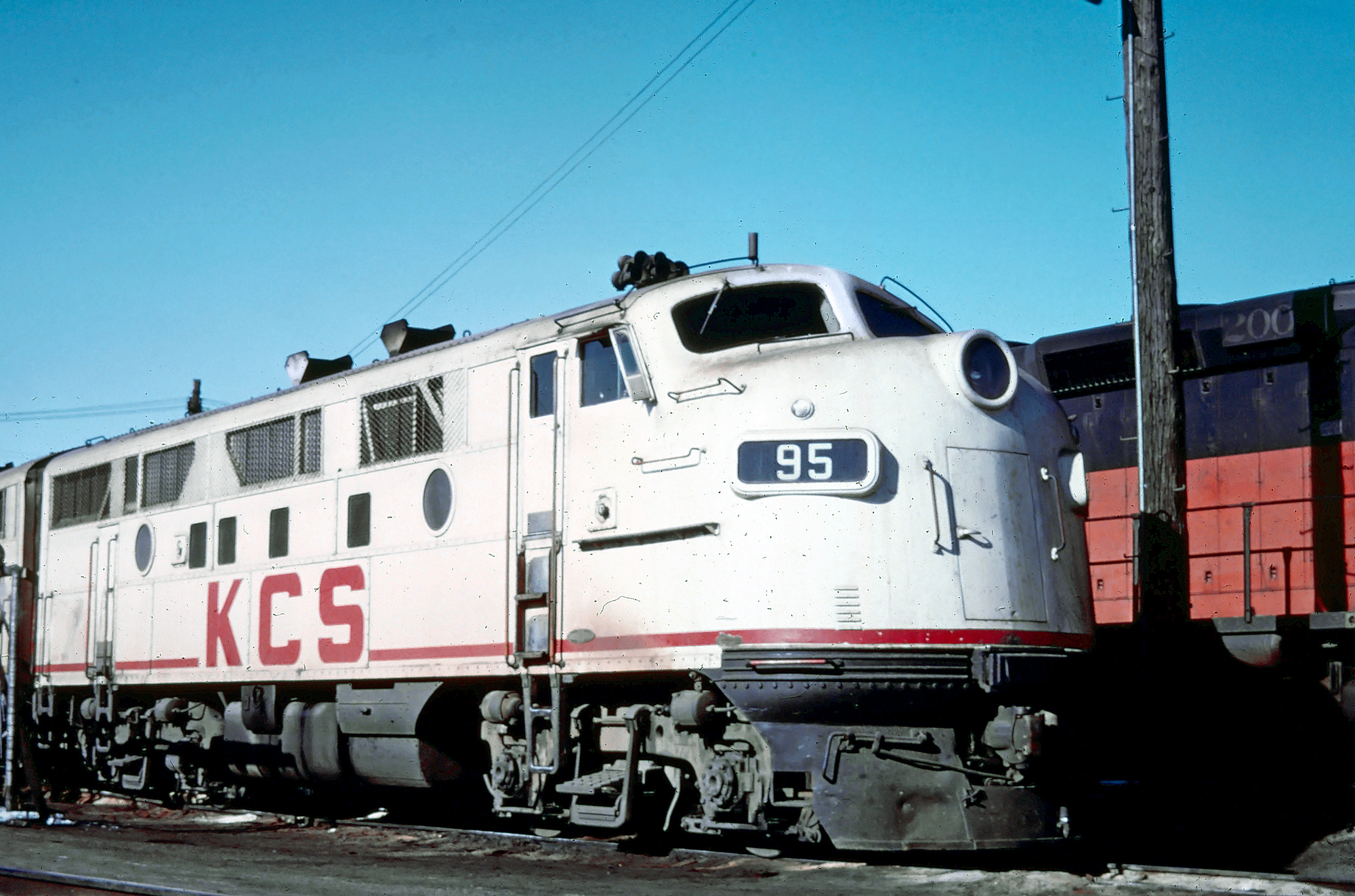 Kansas City Southern F3A #95 lays over in Kansas City, circa, 1977. Mac Owen photo. American-Rails.com collection.
Kansas City Southern F3A #95 lays over in Kansas City, circa, 1977. Mac Owen photo. American-Rails.com collection.The second significant addition was the purchase of Gateway Western (and its subsidiary, Gateway Eastern) in May of 1997. This large regional began service on January 9, 1990.
The GWWR was itself a new startup for the defunct Chicago, Missouri & Western Railway, launched on April 28, 1987 over yet more former Illinois Central Gulf trackage.
The ICG had spent the mid-1980s selling off large chunks of its network in an attempt to reverse its sagging financial condition.
The CM&W operated much of the Gulf, Mobile & Ohio's former main line between Chicago and St. Louis, as well as the corridor between Kansas City and Springfield. In all, it totaled some 633 miles. However, within a year the company was in bankruptcy.
On January 9, 1990 the new Gateway Western Railway was formed by a New York investment firm, acquiring the 408 miles from St. Louis to Kansas City via Springfield while the remainder into Chicago was purchased by Southern Pacific.
The GWWR became successful in part due to the Santa Fe, which utilized trackage rights to reach St. Louis (until the Burlington Northern Santa Fe merger of 1995).
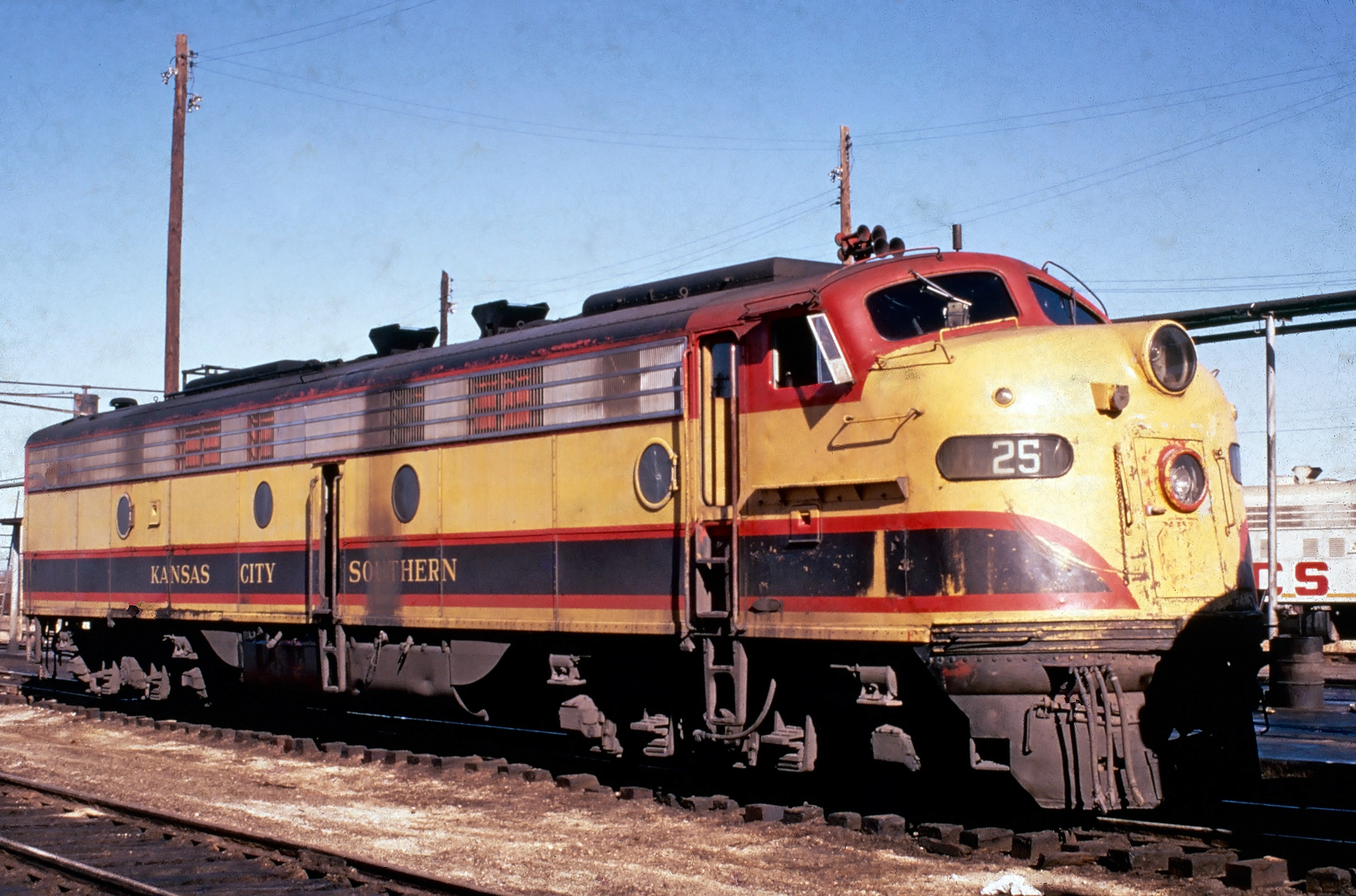 An aging Kansas City Southern E8A, #25, was photographed here by Robert Eastwood, Jr. at the engine terminal in Pittsburg, Kansas, circa 1968. American-Rails.com collection.
An aging Kansas City Southern E8A, #25, was photographed here by Robert Eastwood, Jr. at the engine terminal in Pittsburg, Kansas, circa 1968. American-Rails.com collection.Passenger Trains
While the KCS was never a big player in the passenger market, like several other roads it did have a few notable trains such as the Southern Belle streamliner which operated between Kansas City and New Orleans.
Adorned in an eye-catching Brunswick Green (which appears almost black), yellow, and red the train operated between 1940 and late 1969 until hard times and a weakening passenger market forced its cancellation.
Flying Crow: (Kansas City - New Orleans/Port Arthur)
Shreveporter: (Hope - Shreveport)
Southern Belle: (Kansas City - New Orleans)
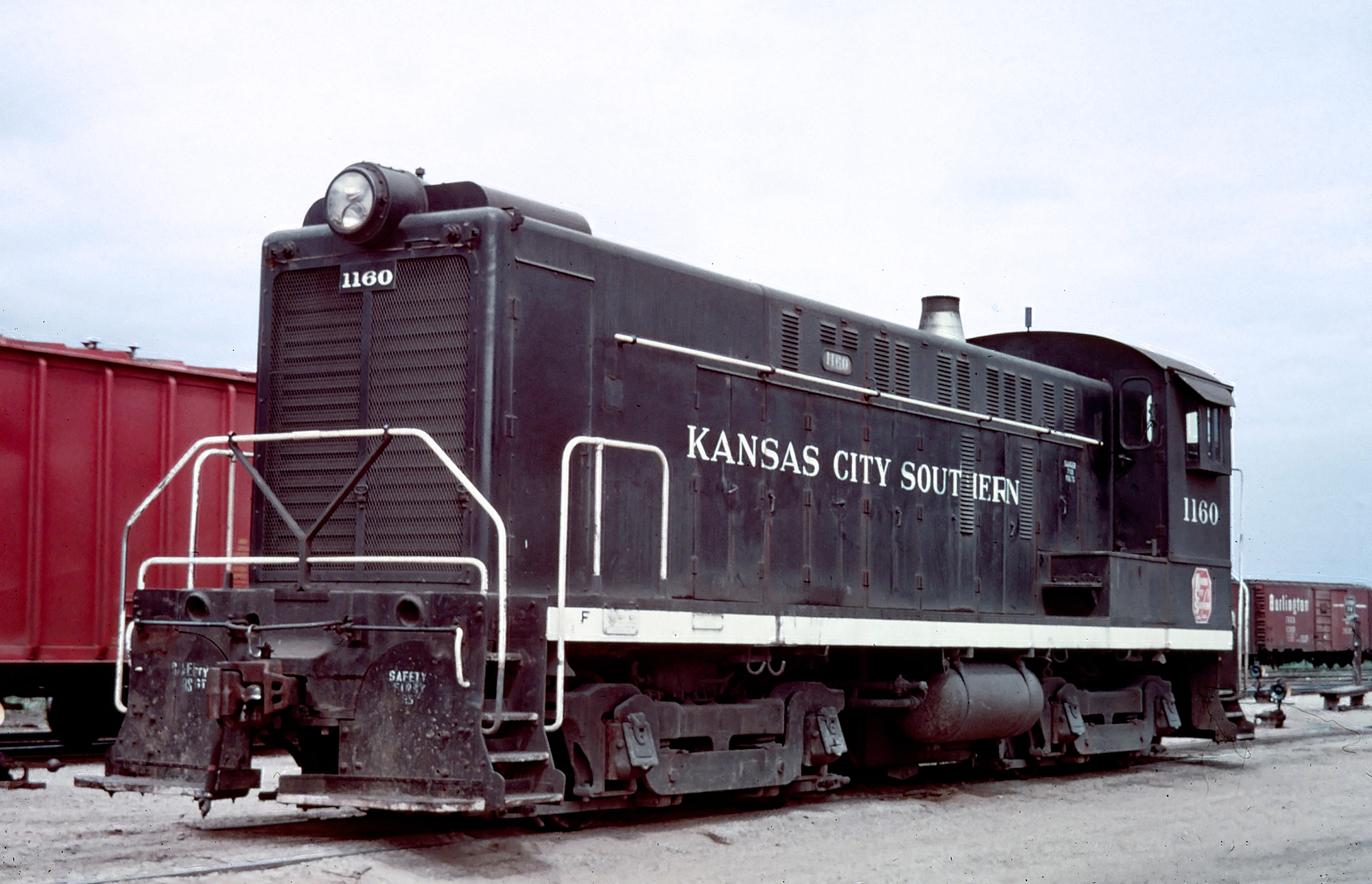 Kansas City Southern S-12 #1160 lays over in Kansas City, circa 1965. American-Rails.com collection.
Kansas City Southern S-12 #1160 lays over in Kansas City, circa 1965. American-Rails.com collection.At about the same time of the aforementioned takeovers, KCS was able to gain complete control of two railroads near, or within Mexico; the Texas Mexican Railway (a southern Texas road that linked with the Mexican border) and Grupo Transportación Ferroviaria Mexicana (TFM).
While the KCS, itself, was only about 3,100 miles in length thanks to acquisitions of Tex Mex and TFM (Kansas City Southern de Mexico), which added about 2,800 miles to its overall system, the railroad boasted a roughly 6,000-mile network.
This trackage still paled in comparison to the other six North American Class Is: Union Pacific and BNSF both maintain about 32,000 miles; CSX Transportation and Norfolk Southern roughly 21,000 miles; Canadian National 20,000 miles; and Canadian Pacific 14,000 miles.
As a result, it was only a matter of time before one of these larger systems acquired the road, which finally occurred with Canadian Pacific's March, 2021 announcement.
Kansas City Southern's logo was unchanged throughout its corporate existence while it featured a number of different paint schemes over the years ranging from whites, reds, blacks, and grays to its switch back to the classic Southern Belle scheme of Brunswick Green, yellow, and red during the mid-2000's.
Diesel Roster
Electro-Motive
| Model Type | Road Number | Date Built | Quantity |
|---|---|---|---|
| E3A | 1-3 | 1938-1939 | 3 |
| E6A | 4-5 | 1942 | 2 |
| E9A | 25 | 1959 | 1 |
| E8A | 26-29 | 1952 | 4 |
| F3A | 30A-31A, 50A-59A, 50D-58D | 1947-1948 | 21 |
| F3B | 30B-31B, 50B-58B, 50C-58C | 1947-1948 | 20 |
| F7A | 32A-33A, 59D, 70A-76A, 72D-76D | 1949-1950 | 15 |
| F7B | 32B-33B, 70B-79B, 72C-78C | 1949-1950 | 17 |
| F9A | 32A, 58D, 74D | 1955-1956 | 3 |
| GP30 | 100-119 | 1962-1963 | 20 |
| GP7 | 150-162 | 1951-1953 | 13 |
| GP9 | 163-165 | 1959 | 3 |
| SD40 | 600-636 | 1966-1971 | 37 |
| SD40-2 | 637-692 | 1972-1980 | 56 |
| SD40X | 700-703 | 1979 | 4 |
| SD50 | 704-713 | 1981 | 10 |
| SD60 | 714-759 | 1989-1991 | 46 |
| GP40-2 | 796-799 | 1979-1981 | 4 |
| NW2 | 1100-1102, 1200-1229 | 1939-1949 | 30 |
| SW7 | 1300-1315 | 1950-1951 | 16 |
| SW1500 | 1500-1541 | 1966-1972 | 42 |
| GP38-2 | 4000-4011 | 1974-1978 | 12 |
| SD70ACe | 4000-4059 (Latest Numbering), 4100-4129 | 2005-2008 | 90 |
| MP15DC | 4363-4366 | 1975 | 4 |
General Electric
| Model Type | Road Number | Date Built | Quantity |
|---|---|---|---|
| ES44AC | 4650-4759 | 2007-2008 | 110 |
Steam Roster
| Class | Type | Wheel Arrangement |
|---|---|---|
| D-25 | Ten-Wheeler | 4-6-0 |
| E (Various) | Consolidation | 2-8-0 |
| F-2 | Switcher | 0-6-0 |
| G | Articulated | 0-6-6-0 |
| G-2 | Articulated | 2-8-8-0 |
| H (Various) | Pacific | 4-6-2 |
| J | Texas | 2-10-4 |
| K, K-1, K-21 | Switcher | 0-8-0 |
| L, L-1 | Santa Fe | 2-10-2 |
| M-22 | Mikado | 2-8-2 |
| S | Shay | 0-4-4-4-0T |
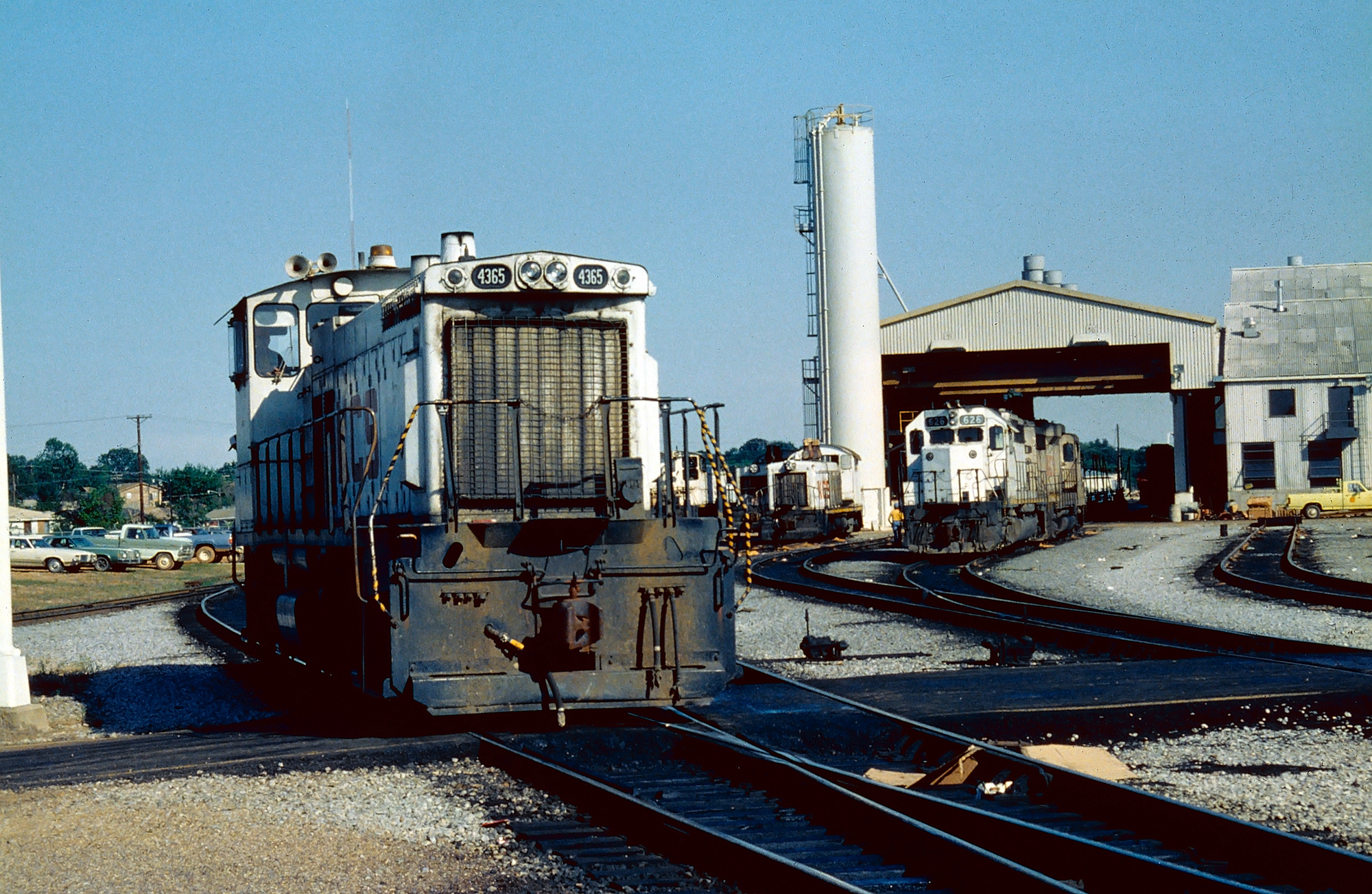 Kansas City Southern MP15DC #4365 is seen here at work near the shops at Deramus Yard in Shreveport, Louisiana, circa 1983. Mike Bledsoe photo. American-Rails.com collection.
Kansas City Southern MP15DC #4365 is seen here at work near the shops at Deramus Yard in Shreveport, Louisiana, circa 1983. Mike Bledsoe photo. American-Rails.com collection.Macaroni Line
The last mileage KCS added was the resurrection of 87.5 miles of former Southern Pacific trackage between Victoria and Rosenberg, Texas, which Trains Magazine reported began service on June 18, 2009.
Also known as the "Macaroni Line" this property came under SP control around 1885 and remained in use until 1985, after which time the trackage was largely pulled up but the right-of-way remained under railroad ownership.
It fell under Union Pacific's jurisdiction after its 1996 takeover of SP and subsequently purchased by Kansas City Southern in 2001. The railroad began first clearing the right-of-way for rehabilitation in 2007 and had it ready for service within a few years.
The new corridor was a vital link to the KCS lines in Mexico and allowed it to discontinue a circuitous 161-mile routing of trackage rights over UP. Today, it sees considerable use and is fully monitored by Centralized Traffic Control (CTC).
Public Timetables (August, 1952)
Additional Sources
- Boyd, Jim. Kansas City Southern, In Color: The Era Of Streamlined Hospitality, 1940-1970. Scotch Plains: Morning Sun Books, 2003.
Contents
Recent Articles
-
Washington Thomas The Train Rides
Dec 21, 25 04:57 PM
This article will take you on a detailed journey through A Day Out With Thomas events held in Washington, offering insights into what makes this experience extraordinary for families and railroad enth… -
Pennsylvania Thomas The Train Rides
Dec 21, 25 03:52 PM
"A Day Out With Thomas” train rides offer a unique opportunity for children and their families to engage in a magical and memorable experience, setting the stage for a full day of fun and adventure. -
Illinois Thomas The Train Rides
Dec 21, 25 12:30 PM
In Illinois, the "A Day Out With Thomas" event offers a unique chance for families to immerse themselves in the enchanting world of Thomas and friends, creating memories that last a lifetime.

